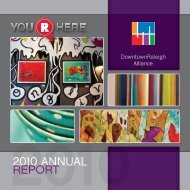Pedestrian Count Study - Downtown Raleigh Alliance
Pedestrian Count Study - Downtown Raleigh Alliance
Pedestrian Count Study - Downtown Raleigh Alliance
Create successful ePaper yourself
Turn your PDF publications into a flip-book with our unique Google optimized e-Paper software.
5. City Comparisons<br />
The methods and procedures for the <strong>Downtown</strong> <strong>Raleigh</strong> <strong>Pedestrian</strong> <strong>Count</strong><br />
are unique to those of the National Bike and <strong>Pedestrian</strong> Documentation<br />
Program. Key differences include the addition of data counts for each<br />
side of the street; an analysis of the late night window from 8:00 p.m. –<br />
2:00 a.m.; and incremental fi nal recording. The following comparisons<br />
extract information from the <strong>Raleigh</strong> <strong>Count</strong> to match existing data<br />
from the NBPDP database. Two similar environments, Knoxville, TN, and<br />
Greensboro, NC, were selected based on the nature of the count<br />
locations: downtown/urban/retail/restaurant; the window of time for<br />
each recording; and the weather conditions during data collection.<br />
A third urban area comparison is included to glean an understanding<br />
of <strong>Raleigh</strong>’s alignment with a larger city. Although quite different in<br />
climate, population and area, San Diego stands as a city with some<br />
well-established cultural areas (East Village, Gaslamp Quarter, etc.) but is<br />
initiating an urban revitalization. Note: Sidewalk widths are not available<br />
for each location.<br />
5.1 Knoxville, Tennessee<br />
The fi ve-year study for Knoxville began in 2005 with recorded pedestrian<br />
and bicycle counts in the spring and fall of each year. The most recent<br />
count data referenced is from April 2009. Weather conditions were slightly<br />
cooler than the <strong>Raleigh</strong> count days, but overall the weather was in the 40s<br />
and 50s (degrees Fahrenheit) with no rain reported.<br />
<strong>Count</strong>s for the Knoxville study were recorded by lump volume in windows<br />
from 7:00 a.m. – 9:00 a.m. and 4:00 p.m. - 6:00 p.m.. This equates to a time<br />
period in the <strong>Raleigh</strong> study of 7:00 a.m. – 9:00 a.m. and 4:00 p.m. – 6:00<br />
p.m. using the 11-Hour <strong>Count</strong> data.<br />
Three locations from the Knoxville study can be used in comparison with<br />
<strong>Raleigh</strong>’s 14 locations in the Fayetteville District 11-Hour <strong>Count</strong>s.<br />
1. Summit Hill and Gay: This intersection in Knoxville is a gateway<br />
to the downtown district with shopping, retail, restaurants, and<br />
offi ces. This location is somewhat similar to the intersection<br />
of Fayetteville and Morgan, in that it is a centrally-located<br />
northern entrance to this downtown area.<br />
2. Gay and Hill: This intersection enters the downtown area from<br />
the south. Although not as programmed as the City Plaza<br />
block in <strong>Raleigh</strong>, the entrance effect is similar.<br />
3. Clinch and Henley: This route runs east-west between<br />
downtown and the University of Tennessee. This particular<br />
location is adjacent to the convention center. No clear<br />
comparison can be made with any <strong>Raleigh</strong> locations, but the<br />
characteristics of a nearly University as well as a convention<br />
center establish this location as compatible for the analysis.<br />
Figure 5.1 illustrates the total count comparison of Knoxville’s three<br />
locations with the total count volume from the <strong>Raleigh</strong> <strong>Study</strong>.<br />
<strong>Pedestrian</strong> <strong>Study</strong> | City Comparisons-5.3<br />
ons-







